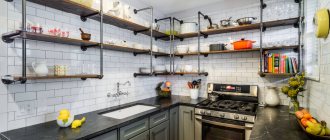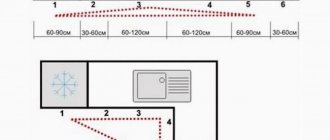Basic principles of ergonomics in the kitchen when planning
The term “ergonomics” itself came to us from the Greek language; literally translated, it consists of two derivatives “ergon” - work, and “nomos” - law. The term denotes a whole section of scientific research related to the study of the work of the human body and the relationship between labor productivity and energy expenditure.
Correct ergonomics in the kitchen is ensured through proper design and arrangement of furniture in such a way that the housewife spends a minimum of effort when working. Studies have shown that following the basic principles of ergonomics in the kitchen will save up to 30% of your time and make your work easier by 50%. Mainly due to compliance with the basic rule of the “working triangle” and compliance with the standards of kitchen furniture with proper placement of household appliances.
Neufert and ergonomics in the kitchen, the triangle rule
The term “work triangle”, familiar to many, was introduced by the German architect Neufert. He proposed optimizing movement between three main centers of activity: the sink, the refrigerator and the stove. Ideally, all three centers should be located at the vertices of an equilateral triangle, then the cost of moving the housewife will be minimal.
But in reality everything turned out to be somewhat more complicated. The layout of small kitchens and large ones, with a regular and elongated shape, may differ. However, the general principles of ergonomics in the kitchen remain the same in all cases:
- The sink is the main center of activity. According to research, the owner spends approximately 50% of all time near her. Therefore, its position, the location of adjacent modules with drawers and wall cabinets with drying should be as convenient as possible.
- The slab is the second most important center of activity. It is advisable to place it at a distance of 800-1200 mm from the sink, in large kitchens - up to 1800 mm. Optimally – as close to the dining area as possible.
- the refrigerator , freezer, and other modules used for storing food in the corner of the kitchen so as not to “tear” the work surfaces into non-functional areas. With proper ergonomics in the kitchen, the refrigerator should be no further than 1200mm from the stove and 1800mm from the sink. But with different kitchen layouts, this distance can either decrease or increase.
General ergonomics of the kitchen space depending on the layout of the unit
Comfort in the kitchen is ensured by many nuances. The less the housewife bends and squats to use the contents of the cabinets, or reaches to get something from the upper cabinets, the less she will get tired. Correct ergonomics in the kitchen also guarantees the absence of “dead” zones, when opening the door blocks the rest of the cabinets and drawers - this should not happen. Also, the level of the working surface should be at a level corresponding to the height.
Here are the TOP 5 useful tips on how to maintain proper ergonomics in the kitchen:
- When designing a kitchen set, consider your own physical parameters. So, the height of the working surface is determined by the arms bent at right angles at the elbows: there should be about 150mm between them and the working surface. And you will forget about back pain when cooking for a long time. Also, the maximum shelf level in wall cabinets should be at the distance of your outstretched arm minus 250mm.
- Make sure there is sufficient lighting on the work surface. Use spotlights for this above the main areas - sink, stove, food processing area. Also plan sockets for connecting household appliances; they should not “go” into the sink and stove areas, this is dangerous.
- Experience shows that the main injury and fire hazards arise near the stove. It should not be located in the aisle, near a pencil case, refrigerator or window with a curtain. The distance from the hob to the hood must be at least 700mm for an electric stove and 800mm for a gas stove.
- With proper ergonomics in the kitchen, the washing machine and dishwasher are located as close as possible to the sink and communications with drainage and water supply. Take care about the placement of sockets for them - they should not be located exactly behind the devices. In this case, in the event of a breakdown or emergency, you will have to pull them out first to turn them off, and this is not the best option.
- The quality of fittings, pull-out and lifting mechanisms is also important so that the ergonomics in the kitchen correspond to a high level of comfort. Doors should open without noise or creaking, just like roll-out and pull-out storage systems. The ease of operation and service life of kitchen furniture as a whole depends on this. If possible, install door closers on your kitchen cabinets; there are plenty of budget options.
General kitchen planning tips that always work
When planning a custom kitchen, try to avoid lower cabinets with hinged fronts whenever possible in favor of drawers and other storage systems. This solution turns out to be more expensive, but is fully justified.
Use mechanisms with closers to smoothly close facades. This will add comfort during operation. Moreover, shock absorbers and door closers built into hinges are not that expensive.
It is better to install a lifting mechanism on a wall cabinet with a built-in drying area above the sink. Often its location is such that the hinged doors “stick out” in front of your face while washing and wiping dishes, irritating and preventing you from fully using the cabinet. If this solution does not suit the design, install hinges on the drying facades with an increased opening angle (180 degrees instead of the usual 90), which will “unfold” the facade.
As already written above, the working surfaces between the refrigerator, sink and stove should be no more than a meter in length. Take care of the height of the lower modules: the position of the tabletop should correspond to your height. You can read more about kitchen furniture standards here.
Proper planning of ergonomics in the kitchen
With all the variety of planning solutions and design projects for the kitchen, all of them can be divided into several types depending on the configuration:
- Linear (straight) and double-row (parallel).
- Angular (L-shaped) and U-shaped.
- Island and circular.
In each layout option, you can follow the triangle rule - the basic principle of ergonomics in the kitchen to minimize the distances between the main centers. And also choose the best solution for placing all other kitchen modules, so that during the work process nothing impedes movement within the “triangle” or blocks the process.
Ergonomics of a linear straight kitchen
A kitchen set stretched out in one line is designed for elongated rooms. Correct ergonomics of a linear straight kitchen requires that the total length of the working surface is no more than 3.5 m. Otherwise the distance between centers will be too large.
If your kitchen is longer, include kitchen cabinets in the project for storing utensils and integrating household appliances.
It is best to place the refrigerator at one end of the kitchen, and move the sink to the center, between the stove and the refrigerator. True, this is not always possible; usually all communications for connecting the water supply and drainage are located in the corner of the kitchen. But there is an option to “move” the sink using a dishwasher or washing machine, which can be placed in the corner of the kitchen.
Ergonomics of a two-row parallel kitchen
A parallel layout in the kitchen is used in walk-through elongated rooms. As a rule, two key centers are located along one wall - a stove and a sink, and along the other - a dining area, a refrigerator and cabinets for storing food and kitchen utensils.
The ergonomics of a modern kitchen with a double-row arrangement of cabinets should take into account the possibility of free opening of all kitchen modules. For example, to open the oven or pull it out, the housewife needs a passage 1-1.2 m wide. And to open a narrow façade 300-400mm wide, you need less space. Design the opening of kitchen cabinets and cabinets so that the ergonomics of the kitchen space allows this to be done comfortably.
Ergonomics of a corner kitchen
A corner or L-shaped kitchen layout allows you to fully realize the requirements of Neufert's working triangle. The ergonomics of a small kitchen with a corner configuration will be most convenient, since the two key centers - the sink and the refrigerator, the refrigerator and the stove - will not be so far apart from each other.
In the case of a large, spacious kitchen, it is recommended to “move” the key centers to optimize the distance between them through additional pencil cases and other kitchen modules.
Ergonomics of a U-shaped kitchen
The U-shaped configuration of the kitchen set is an arrangement of kitchen modules along three walls of the room. It is possible to maintain correct ergonomics in a U-shaped kitchen if there is enough free space both for the housewife to move and for opening all cabinets and cabinets.
To do this, the minimum free space between two rows should be about 1200-1500mm. Otherwise, the kitchen will be cramped and uncomfortable.
Ergonomics of a kitchen with an island
Island compositions in the kitchen allow you to ergonomically space out work surfaces, making the kitchen more convenient and compact for movement between key centers. At the same time, the island can be effectively combined with straight, corner and U-shaped layouts - it all depends on the size of the kitchen and the personal wishes of the hostess.
The work surface of the island is most often used to place a stove or sink. True, it is quite difficult to arrange such a solution from the point of view of the possibility of supplying communications for connecting household appliances and a water supply system if it is planned to move a sink to the island. Therefore, the kitchen design project should be determined at the stage of rough renovation, with planning of sockets and water supply and drainage connections. The distance between the island and the bottom row of the kitchen should be sufficient for free movement and opening of all modules.
By the way, you can make a kitchen island with your own hands.
Kitchen layout and work triangle
The familiar “triangle rule” is still relevant today. After all, in a modern kitchen there are still three main “centers of gravity”:
- Fridge.
- Washing.
- Plate.
Between them, in the process of developing the design project and planning, the above-mentioned areas for storing, processing food and cooking are distributed. However, this does not always happen. There are always exceptions.
For example, a built-in stove can be “spaced out”: a hob with a hood is installed in one place in one place, and an oven with a microwave is placed in a separate cabinet.
The refrigerator is often located on a separate wall outside the kitchen unit, next to the dining area.
Therefore, you should not blindly follow the established “rules” - each design project can be quite non-standard, but no less convenient and “correct” from an ergonomic point of view.
When designing, they usually rely on the chosen kitchen layout: it can be linear, corner, U-shaped or island.
In a medium-sized corner kitchen, the easiest way is to follow the “triangle rule”.
For more spacious ones, it already loses its meaning - the working surfaces between three points (stove, sink and refrigerator) turn out to be too long. It is optimal to make them no more than a meter. This way it will be more convenient for the housewife to move from one zone to another, without wasting time and effort on unnecessary movement.
Ergonomics of a small kitchen
To comply with the basic principles of ergonomics in a small kitchen, a corner configuration is most suitable. Depending on the size, it is often necessary to place all the key centers of the working triangle along one line. Since it is not advisable to move the stove to the edge of a small-sized kitchen in order to avoid traumatic situations.
With a competent approach to developing a design project, all large-sized household appliances can be placed in a small kitchen and at the same time provide the hostess with the most comfortable conditions. How? Check out the layout drawings for a small-sized kitchen - perhaps many points will become clearer to you.
Table top height
Correctly selected height of the kitchen countertop is the secret to comfortable use of the entire room and successful kitchen arrangement. Therefore, the installation of the countertop should be carefully considered, since it is mainly used in the kitchen.
About ten years ago, the standard height of a kitchen countertop was 85 cm ; today this solution is increasingly being abandoned. The 85 cm high table top is only suitable for shorter people (e.g. up to 165 cm). Therefore, the current standard countertop height is already 85 – 90 cm , and the height of kitchen cabinets, especially wall-mounted ones, is also changing.
The second height option is aimed at tall users (up to 180 cm). However, you need to remember that a kitchen countertop with a height of 90 cm will not be very comfortable for tall people.
Cooking will cause them to posture incorrectly, which may be associated with back pain. Therefore, it is recommended to individually select the tabletop to suit the height of the users.
It’s easy to calculate the optimal height of the countertop in the kitchen; just stand straight and bend your elbows. The forearm should be parallel to the floor. The second person should measure the distance from the floor to the forearm with a ruler. We subtract from 15 to 20 cm from the result. The value of the calculations will show us the ideal height of the tabletop, individually selected for the user.
Ergonomics of a combined kitchen with dining room and living room
A spacious kitchen often involves combining it with a living or dining area. Therefore, island kitchen configurations are more suitable for arrangement. The kitchen island seems to separate the kitchen space from the living space. At the same time, it often serves as a dining area - bar counters and dining tables are attached to it.
The U-shaped layout also lends itself well to the ergonomics of a large kitchen. In this case, one of the sides of the U-shaped configuration is not located along the wall, but separates the kitchen space in the form of a kind of bar counter.
If the room allows, you can use a circular kitchen layout - giving a rounded, streamlined shape to an island or U-shaped configuration. Such design solutions look especially impressive in modern interior solutions.
Dimensions for built-in household appliances
When purchasing equipment, you must take into account whether it will fit the size of the niche, that is, the cabinet where it will be placed. Information about this is written in the instructions, but you can take it with you to the furniture tape measure.
Standard niche with a width of 60 cm for a built-in oven: width – 568 mm, height – 720 mm, depth – 550 – 570 mm.
There are also other dimensions (45, 80 or 90 cm). In this case, take into account:
- frame wall thickness – 16 mm;
- height of cabinet frames – 720 mm;
- depth – 550 – 570 mm.
Same with the rest of the equipment. Let’s say the cabinet for equipment is 60 cm wide, what should the dimensions be:
- fridge. Height – 1770 or 2150 mm. Width – 568 mm;
- Microwave (microwave oven). Height – 380 mm. Width – 568 mm;
- dishwasher or washing machine. Height – 850 – 910 mm. Width – 600 mm.
The depth in all cases is 550 – 570 mm.
What to do if you have a regular washing machine and want to build it into the countertop? To do this, unscrew the top cover of the equipment. There are usually no issues with width - most models fit into cases with a width of 600 mm.
Peculiarities
What height should the apron be given the standard sizes of cabinets and kitchens is already known. In addition, you need to understand important features:
- experts advise making a small overlap, which is often 2–3 cm. It is determined by the size of the cabinets, and a larger width will look unsightly;
- the size of the apron is not a constant value, but variable, because under the hood the indicators should be larger;
- Facing materials play an important role. For example, when using tiles, it is better not to trim, but to increase the overlap boundaries. If you use skinali, then you won’t be able to adjust the dimensions - it’s easier and cheaper to change the level of the cabinets;
- Kitchen design features also leave their mark on the apron. The loft style has become very popular, in which not a single wall kitchen cabinet is installed. The set is replaced by a long shelf and an open hood. With loft, the apron will be arbitrary.
First of all, an apron is made to protect the walls, but an important role is played by design requirements. The classic style with conventional wall furniture and hinged doors always includes a protective part of a standard or optimal value. It is not recommended to make an area less than 47–57 cm, since a visual cluttering effect appears.
In modern design, they prefer to use wall cabinets elongated in a horizontal plane, the doors of which open upward. In this case, the width of the protective surface is always greater than the standard, and is 70–75 cm.
With high ceilings in a house or apartment, the upper part of the furniture is almost always mounted under the ceiling, the height is approximately 2 m from the floor level. In this case, the apron is made 110–117 cm, which is considered the maximum.
If there is no plan for hanging furniture in the kitchen, then the facing part of the walls is chosen at the discretion of the owner, for example, up to the level of the shelves.
The standard between cabinets and countertops does not have strict requirements and boundaries; it all depends on the size of the kitchen tables, furniture, and interior.
Kitchen zoning
The basis for creating an ergonomic kitchen is the correct arrangement of functional areas. The refrigerator is usually the center of most activity because it houses the bulk of food preparation supplies.
Its location directly depends on the parameters of the kitchen. In medium-sized kitchens, the refrigerator should be placed, firstly, taking into account the opening of the door so that the passage is not blocked, and secondly, away from the front door - to ensure free entry into the room. For a small family, an excellent solution would be a refrigerator drawer with a freezer located under the countertop.
When the “working triangle” is installed according to the linear version, its components look like this: refrigerator - sink - hob. This ensures the sequence of stages in the food preparation process.
The issue of size in kitchen ergonomics
It is important to pay attention to the vertical dimensions of equipment and furniture. Only by selecting them at the same height can you create a single work surface, without gaps or differences, on which dishes can move freely, for example, from the stove to the countertop and back.
The level of placement of drawers and shelves is of great importance. The total height of the kitchen equipment is divided into four zones:
- Very low - starts from the floor and ends at 40 cm in height. Not only is it inconvenient, but it also has the least visibility. It is used for large items that are rarely used.
- Low - ranges from 40 to 75 cm. Drawers and cabinet shelves at this height can be used to store small household appliances, pots and pans.
- Medium - starts from 75 cm and ends at 190 cm. This is the most comfortable level. At this height it is best to store small, fragile items, everyday dishes, sets and cutlery, as well as products of constant use.
- High - from 190 cm to ceiling level. It is used when absolutely necessary in small kitchens to save space. It is inconvenient, since you can only get anything from such a height with a stepladder or stool. Light, unbreakable items are stored in it.
The installation of wall cabinets should be done taking into account the height of the people who will cook in the kitchen. For a housewife of average height, a distance of 45–50 cm from the work surface to the bottom of the hanging cabinet is considered sufficient.
For the hood to work effectively, you need to maintain the following distances between it and the hob: 70-75 cm (electric stove) and 75-80 cm (gas stove).
Kitchen ergonomics, first of all, ensures the safety of the food preparation process. That is why the stove is always placed away from the passage so as not to touch hot pots and pans. To prevent splashes of water from extinguishing the fire, a distance of at least 0.4 m is provided between the stove and the sink and covered with a table top, and between the stove and the window - 0.5 m, thereby preventing the curtains from catching fire.
Ergonomic principles
Smart kitchen planning can save up to 30% of your precious time and 60% of your effort. We encourage you to familiarize yourself with these rules.
First: "Silence"
Ergonomics of space implies a quiet workplace. Agree that squeaky doors or drawers are annoying. In other words, the furniture must be in good working order so that nothing creaky or unpleasant distracts the housewife from the cooking process.
Second: “Everything is at hand!”
The movements of the housewife who prepares food in the working triangle should be kept to a minimum. This means that everything you need should be at hand.
Products, place, cutlery, towels, cutting boards, spices. Drawers next to the sink and stove will allow you to quickly find the necessary item.
Third: “Household appliances in one place”
Today, household appliances greatly facilitate the housewife’s work. Ergonomics of household appliances, when a coffee maker, electric kettle, and microwave oven stand together, occupy a small space and are located near an electrical outlet.
Moreover, it is better to place the microwave in the upper cabinet. If there is a TV in the kitchen, then it is better to place it on top. It is more convenient to place the washing machine in the place where the rest of the kitchen appliances are concentrated.
Fourth: “What height should the work surface be?”
To avoid leaning too much over the table, you need to provide yourself with the right workplace. Then your back and arms will not get tired. The optimal height of the tabletop is when your hands are at an angle of 45˚ from the surface.
Fifth: “You need to take care of your back!”
Ergonomics is when the placement of furniture will help you not to reach too high and not to squat when you need to reach something below. The upper modules should be at the appropriate height, and it is better to replace the doors of the lower modules with drawers.
By the way, many people come to the conclusion that it is better to use wall shelves instead of upper cabinets with doors. The oven should be installed at countertop level, while storing pans and heavy dishes is more appropriate in lower cabinets or on lower shelves - it is easier to reach heavy items from below than from above.
Sixth: “Extra space”
The space under the sink, as well as the apron area, needs to be properly organized: under the sink you can store cleaning products, garbage bags and other “little things”. The necessary accessories will always be in sight if you hang them (for example, jars of spices, a slotted spoon).
One light source in the kitchen is clearly not enough. Additional adjustable light must be provided.
Eighth: “Instead of handles on doors”
We are talking about the “push” system, which will allow you to open the door by simply pressing the facade. The system also makes cleaning furniture surfaces easier. Many intuitively use these principles in room planning! We hope our tips will help you cook quickly and effortlessly in the kitchen.











